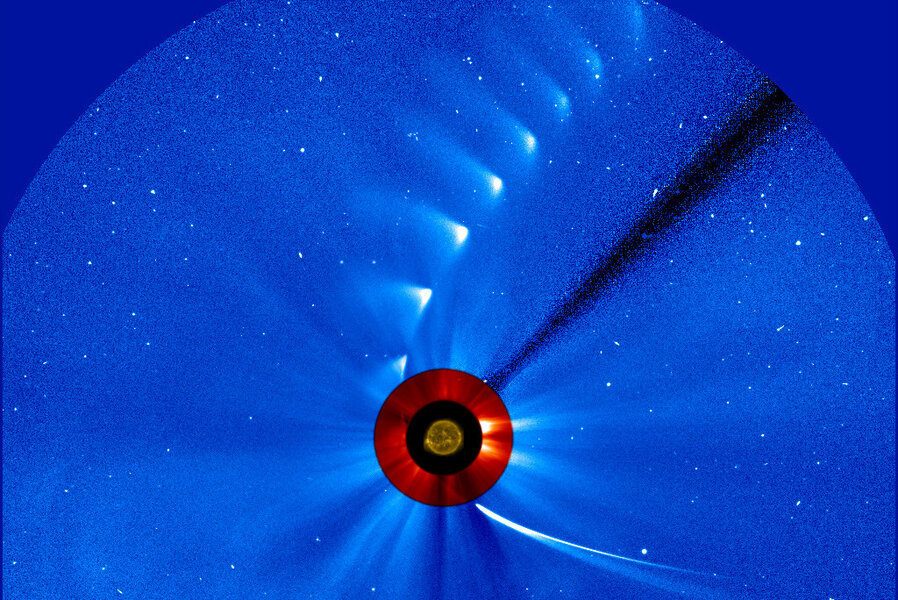Did Comet ISON just ruin Christmas?
'Twas the month before Christmas,
And all through the land,
Star-spotters were seeking
A comet that's grand.
With binocs and telescopes
And equipment quite pricey,
Astronomers hoped to spot
Space dust, quite icy.
On SOHO! On STEREO!
On Earth-based observers!
But no glowing comet
Showed up on our servers.
A trace of, well, something
Kept faint hopes alive.
Is it still a comet?
Did something survive?
Despite all our hopes,
Could ISON be gone?
We hunted for proof
That the comet lived on...
Comet ISON brushed within less than a million miles of the sun on Thursday. When it did not quickly emerge on the other side of the sun, many astronomers gave it up as lost – another comet following in the doomed footsteps of the mythological Icarus, who flew too close to the sun and was destroyed. But then astronomers caught a glimpse of a surprisingly small space rock where ISON should have been, prompting rumors that the "zombie comet" might not have died after all, and was continuing its path around the sun.
After several days of continued observations, NASA scientists are still uncertain about ISON's fate. "There's no doubt that the comet shrank in size considerably as it rounded the sun," says NASA, "and there's no doubt that something made it out on the other side to shoot back into space. The question remains as to whether the bright spot seen moving away from the sun was simply debris, or whether a small nucleus of the original ball of ice was still there. Regardless, it is likely that it is now only dust."
Amateur astronomers, hoping that Comet ISON would live up to its early reputation as the "Comet of the Century," are disappointed. Whatever has emerged, it won't be visible to the naked eye throughout December, as early reports suggested.
Why the early hype? "Simply put, ISON peaked early," wrote Josh Sokol, a member of the Hubble Space Telescope Heritage Team. "When it was first discovered, way out past Jupiter, ISON was really bright. Extrapolated, those first data points made ISON look like it would shine even more as it got closer." As the months passed, it became clear that ISON would not fulfill its early potential.
ISON began its journey to the sun some 3 million years ago. Several months ago, several NASA telescopes, including some orbiting Mars and Mercury, spotted the small sun-grazer. Some of the best images came from NASA's Solar Terrestrial Relations Observatory (STEREO) and the joint European Space Agency/NASA Solar and Heliospheric Observatory (SOHO), via images that block out the too-bright sun and its surroundings in order to better observe dim structures in the sun's neighborhood.
Because of the sun-blocker in the middle of these "coronagraphs," ISON couldn't be seen for the climactic hours surrounding its brush with the sun. But then, after an agonizing wait, something dim appeared in SOHO and STEREO coronagraphs.
NASA scientists identified it as a cloud of dust, but whether it meets the definition of a comet is still uncertain. The key question: Does it have a nucleus?
Before it got to the sun, ISON had an obvious nucleus – a small ball of its original, icy material – surrounded by a glowing head (coma) and tail. If the nucleus has broken apart, like a powdery snowball, then ISON must be demoted to a "cloud of dust" and is a comet no longer.
As of Dec. 1, there appeared to be no nucleus left, say scientists. Astronomers will continue to monitor the dust, but the best chance to answer the question of ISON's status will come when Hubble makes observations later this month.
"Regardless of its fate, Comet ISON did not disappoint researchers," says NASA. "Over the last year, observatories around the world and in space gathered one of the largest sets of comet observations of all time, which should provide fodder for study for years to come. The number of space-based, ground-based, and amateur observations were unprecedented, with twelve NASA space-based assets observing over the past year."
But for those of us hoping for a Christmas comet that would light the skies from Thanksgiving till its closest approach to Earth on Dec. 26, ISON's disintegration might as well have been total.
ISON blasted straight sun-ward
From the Oort like a missile,
But now its dust flies
Like the down of a thistle.
We all held our breath
As it flew out of sight,
But we'll never see ISON
Light up a dark night.
You can follow Liz on Twitter at @lizfullerwright. Liz offers abject apologies to Clement Clarke Moore, author of "A Visit From Saint Nicholas."







